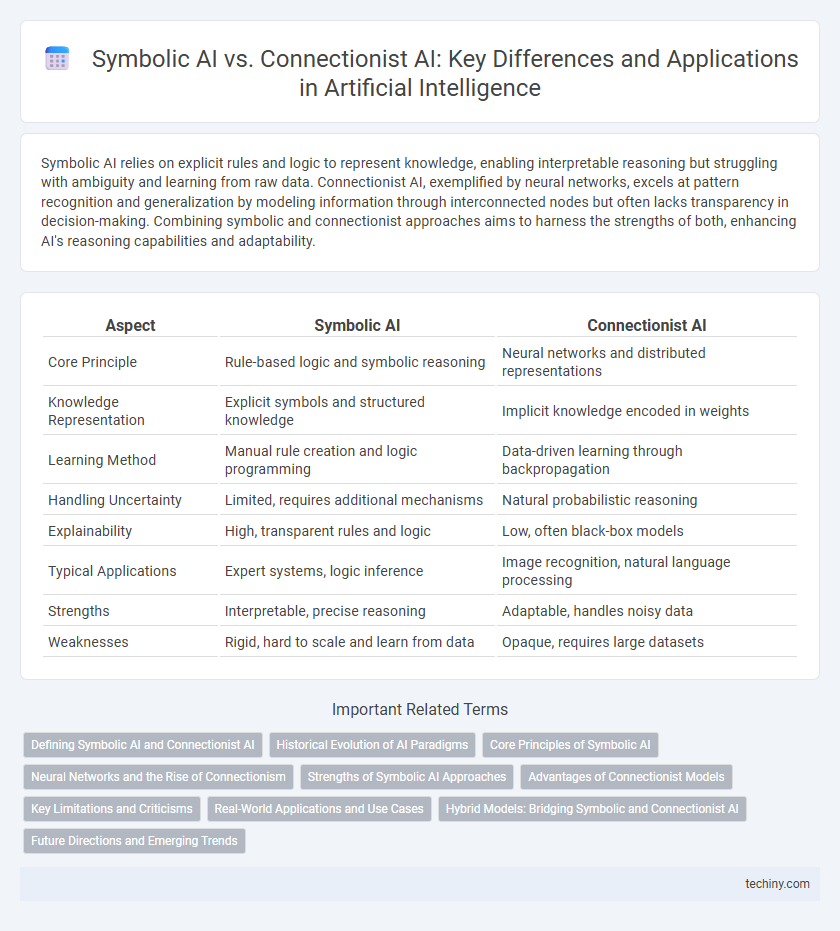Symbolic AI relies on explicit rules and logic to represent knowledge, enabling interpretable reasoning but struggling with ambiguity and learning from raw data. Connectionist AI, exemplified by neural networks, excels at pattern recognition and generalization by modeling information through interconnected nodes but often lacks transparency in decision-making. Combining symbolic and connectionist approaches aims to harness the strengths of both, enhancing AI's reasoning capabilities and adaptability.
Table of Comparison
| Aspect | Symbolic AI | Connectionist AI |
|---|---|---|
| Core Principle | Rule-based logic and symbolic reasoning | Neural networks and distributed representations |
| Knowledge Representation | Explicit symbols and structured knowledge | Implicit knowledge encoded in weights |
| Learning Method | Manual rule creation and logic programming | Data-driven learning through backpropagation |
| Handling Uncertainty | Limited, requires additional mechanisms | Natural probabilistic reasoning |
| Explainability | High, transparent rules and logic | Low, often black-box models |
| Typical Applications | Expert systems, logic inference | Image recognition, natural language processing |
| Strengths | Interpretable, precise reasoning | Adaptable, handles noisy data |
| Weaknesses | Rigid, hard to scale and learn from data | Opaque, requires large datasets |
Defining Symbolic AI and Connectionist AI
Symbolic AI, also known as Good Old-Fashioned AI (GOFAI), relies on explicit rules and symbolic representations to model human reasoning through logic and structured knowledge bases. Connectionist AI, commonly referred to as neural networks or deep learning, employs interconnected layers of nodes that simulate brain-like learning by processing vast amounts of data and recognizing patterns. These two paradigms represent distinct approaches to artificial intelligence: the former emphasizes symbolic reasoning and manipulation, while the latter focuses on learning from data using distributed representations.
Historical Evolution of AI Paradigms
Symbolic AI, dominant from the 1950s to the 1980s, emphasized rule-based systems and logical reasoning to simulate human intelligence. Connectionist AI, emerging in the 1980s with the advent of artificial neural networks, focuses on learning from data through interconnected nodes inspired by biological neurons. The historical evolution reflects a shift from explicit knowledge representation to data-driven models, shaping modern AI advances like deep learning.
Core Principles of Symbolic AI
Symbolic AI is based on the manipulation of high-level, human-readable symbols and rules to represent knowledge and logic, enabling explicit reasoning and problem-solving processes. It emphasizes formal structures such as ontologies, symbolic logic, and knowledge representation frameworks to encode information in a modular and interpretable manner. Core principles include rule-based inference, declarative knowledge representation, and symbolic manipulation, which contrast with the sub-symbolic, data-driven learning methods of Connectionist AI.
Neural Networks and the Rise of Connectionism
Neural networks, a core component of Connectionist AI, simulate the interconnected structure of human neurons to enable machines to learn from data patterns, surpassing the rule-based limitations of Symbolic AI. The rise of Connectionism marks a shift towards data-driven approaches, leveraging deep learning techniques to solve complex problems such as image recognition and natural language processing. Advances in computational power and large datasets have accelerated the success of connectionist models, positioning them as a dominant paradigm in modern artificial intelligence research.
Strengths of Symbolic AI Approaches
Symbolic AI excels in handling complex reasoning tasks through explicit knowledge representation and rule-based manipulation, enabling clear interpretability and transparency in decision-making processes. Its strength lies in the ability to encode domain-specific expertise into structured forms like ontologies and logic rules, facilitating precise problem-solving and explanation generation. This approach supports reliable knowledge transfer and verification, which is crucial for applications requiring causality and deductive reasoning.
Advantages of Connectionist Models
Connectionist AI models, particularly neural networks, excel in pattern recognition and learning from unstructured data by mimicking the brain's interconnected neuron structure. These models offer robust adaptability to noisy or incomplete information, enabling superior performance in tasks like image and speech recognition compared to Symbolic AI. Their ability to generalize from examples without explicit rule programming significantly enhances scalability and practical application across diverse AI challenges.
Key Limitations and Criticisms
Symbolic AI faces criticism for its limited ability to handle ambiguous, uncertain, or incomplete data, relying heavily on predefined rules and logic which restricts scalability and adaptability in dynamic environments. Connectionist AI, while excelling in pattern recognition through neural networks, struggles with explainability and transparency, making it difficult to interpret decision processes and ensure accountability. Both approaches encounter challenges in integrating common sense reasoning and context understanding, hindering robust real-world application.
Real-World Applications and Use Cases
Symbolic AI excels in rule-based systems such as expert systems and natural language processing for legal and medical domains, leveraging human-readable logic for explainability and precise reasoning. Connectionist AI, particularly deep learning models, dominates in image recognition, speech synthesis, and autonomous driving by learning patterns from vast datasets without explicit programming. Hybrid approaches increasingly combine symbolic reasoning with neural networks to improve interpretability and robustness in complex real-world applications like robotics and decision support systems.
Hybrid Models: Bridging Symbolic and Connectionist AI
Hybrid models in Artificial Intelligence combine the rule-based precision of Symbolic AI with the adaptive learning capabilities of Connectionist AI, enabling more robust problem-solving and reasoning. These models utilize symbolic representations to handle high-level cognitive tasks while leveraging neural networks for pattern recognition and data-driven learning. Such integration advances AI systems towards improved interpretability, flexibility, and generalization in complex environments.
Future Directions and Emerging Trends
Future directions in Symbolic AI emphasize enhanced knowledge representation and reasoning through integrating ontologies with probabilistic models for improved explainability. Connectionist AI is advancing with neuro-symbolic systems that combine deep learning's pattern recognition capabilities and symbolic reasoning for more robust generalization. Emerging trends include hybrid architectures leveraging explainable AI frameworks to address complex real-world problems in natural language understanding and autonomous decision-making.
Symbolic AI vs Connectionist AI Infographic

 techiny.com
techiny.com